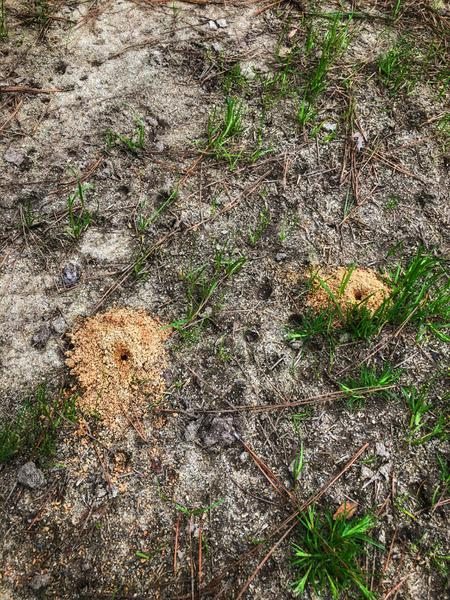The Buzz on Ground Nesting Bees
go.ncsu.edu/readext?803151
en Español / em Português
El inglés es el idioma de control de esta página. En la medida en que haya algún conflicto entre la traducción al inglés y la traducción, el inglés prevalece.
Al hacer clic en el enlace de traducción se activa un servicio de traducción gratuito para convertir la página al español. Al igual que con cualquier traducción por Internet, la conversión no es sensible al contexto y puede que no traduzca el texto en su significado original. NC State Extension no garantiza la exactitud del texto traducido. Por favor, tenga en cuenta que algunas aplicaciones y/o servicios pueden no funcionar como se espera cuando se traducen.
Português
Inglês é o idioma de controle desta página. Na medida que haja algum conflito entre o texto original em Inglês e a tradução, o Inglês prevalece.
Ao clicar no link de tradução, um serviço gratuito de tradução será ativado para converter a página para o Português. Como em qualquer tradução pela internet, a conversão não é sensivel ao contexto e pode não ocorrer a tradução para o significado orginal. O serviço de Extensão da Carolina do Norte (NC State Extension) não garante a exatidão do texto traduzido. Por favor, observe que algumas funções ou serviços podem não funcionar como esperado após a tradução.
English
English is the controlling language of this page. To the extent there is any conflict between the English text and the translation, English controls.
Clicking on the translation link activates a free translation service to convert the page to Spanish. As with any Internet translation, the conversion is not context-sensitive and may not translate the text to its original meaning. NC State Extension does not guarantee the accuracy of the translated text. Please note that some applications and/or services may not function as expected when translated.
Collapse ▲This article was written by Gail Griffin, Extension Master Gardener℠ Volunteer in Lee County.
With the approach of warm weather and the abundance of flowering plants in the landscape, our native bees are beginning to take notice and starting their annual nesting rituals. These include a species of solitary bees known as ground-nesting bees. Here’s the buzz.
About ninety percent of bees native to our state are solitary bees. They are categorized as solitary because a single female lays an egg in a single larval cell unlike social bees, such as honey bees, that thrive in colonies. Adult bees develop and emerge from the ground and mate in spring. The females excavate burrows in the ground, sometimes in close proximity to other burrows. They form several cells in each burrow, then go out in search of pollen and nectar which they bring back and form into a ball. Upon each ball, she lays a single egg and after filling several brood cells in the nest with eggs, she seals the entrance and goes on to form another nest. She leaves the eggs to fend for themselves. After they hatch, they feed on the pollen and stay in the larval stage underground until the following year. This activity only lasts a few weeks as the bee’s life cycle soon ends. Ground nesting bees include the species of mining bees, leafcutter bees, membrane bees, and sweat bees.
the ground, sometimes in close proximity to other burrows. They form several cells in each burrow, then go out in search of pollen and nectar which they bring back and form into a ball. Upon each ball, she lays a single egg and after filling several brood cells in the nest with eggs, she seals the entrance and goes on to form another nest. She leaves the eggs to fend for themselves. After they hatch, they feed on the pollen and stay in the larval stage underground until the following year. This activity only lasts a few weeks as the bee’s life cycle soon ends. Ground nesting bees include the species of mining bees, leafcutter bees, membrane bees, and sweat bees.
Ground nesting bees seek out warm, dry areas with sun exposure, usually south-facing. They push up mounds of soil beside the burrows and are sometimes mistaken for fire ants. They prefer thin, bare ground with little organic matter and can often be found in turf. They do not cause thinning of these areas, but will take advantage of these conditions if they are present. They play an important role as pollinators as they travel from plant to plant in search of nectar. They do not pose a threat and usually will not sting unless handled or stepped on. They are not “programmed” to sting like yellow jackets. There are no biological controls and chemical control is not usually necessary. For recommendations, contact your local extension office. By irrigating heavily, applying heavy mulch, thickening the turf, or growing a ground cover, these bees will be encouraged to find other, more favorable nesting sites. These important insects are a necessary part of our environment and are only around for a short while. Maybe for now we just need to leave ’em be.
For more information on ground-nesting bees, see the NC State Extension publication Ground-Nesting Bees in Turf.
Gail Griffin is an Extension Master Gardener Volunteer in Lee County.




